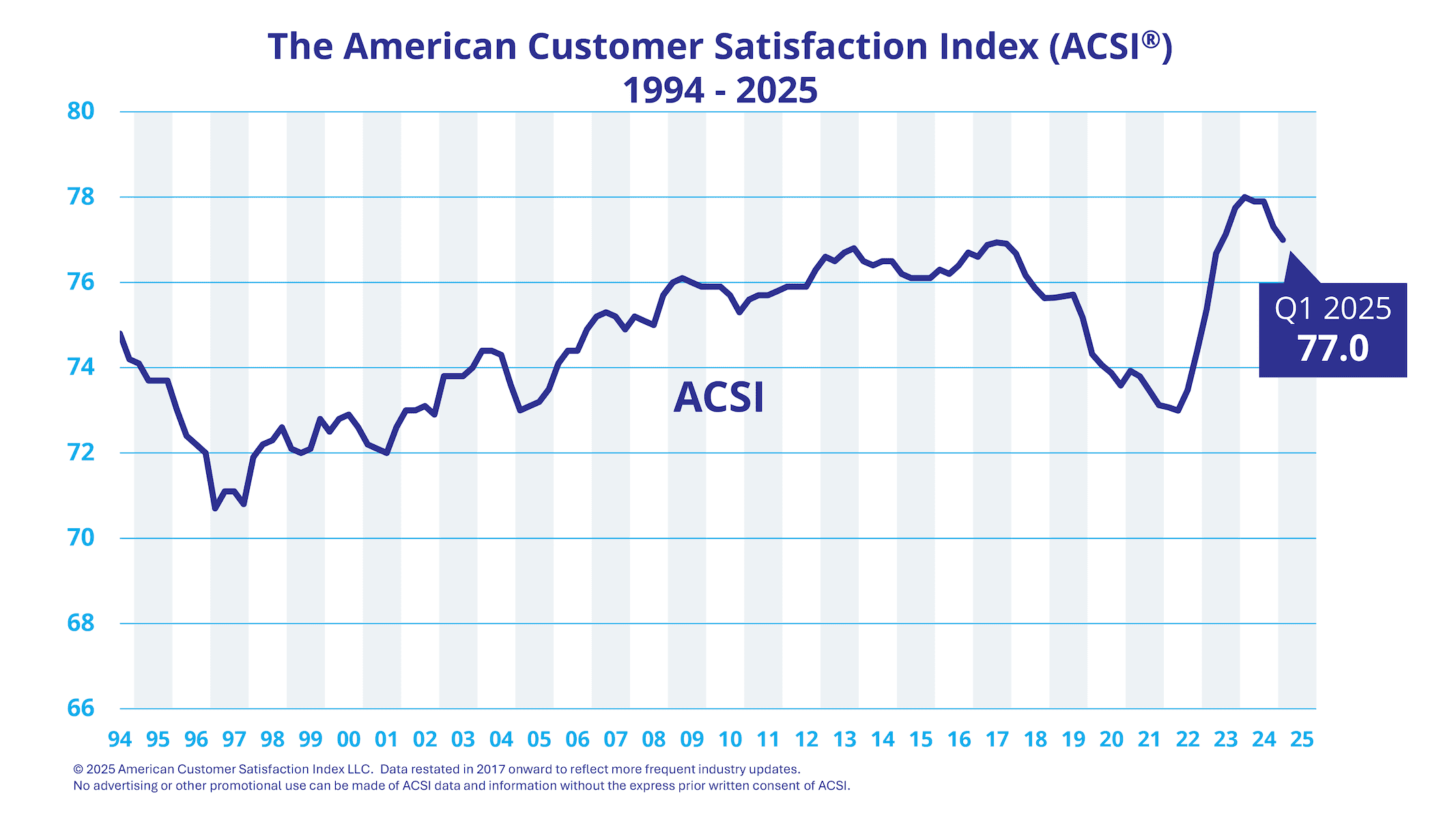The American Customer Satisfaction Index (ACSI) was established in 1994 at the Ross School of Business, the University of Michigan, under the leadership of Claes Fornell, the Distinguished Donald C. Cook Professor Emeritus of Business Administration. Expressed as a system of latent variable equations and populated with data from about 200,000 customers/consumers annually, ACSI tracks the quality of economic output (products and services) in the US – as gauged by the consumers of that output. ACSI is complementary to GDP, which measures the (value of) quantity of economic output. Over the years, more than 16,000 peer-reviewed scientific articles confirm that company-level ACSI scores have an impact on earnings, cash flow, stock returns, earnings surprises, ROI, and a number of other important business performance metrics.
U.S. CUSTOMER SATISFACTION FALLS
Q1 2025: The American Customer Satisfaction Index (ACSI)
ANN ARBOR, Mich., (May 13, 2025) —
As the gross domestic product (GDP) contracted and consumer sentiment fell, overall U.S. customer satisfaction declined 0.4% in the first quarter of 2025 to a score of 77.0 (on a scale of 0 to 100), according to the American Customer Satisfaction Index (ACSI®). The Index has remained flat or dropped in four consecutive quarters — something that hasn’t occurred since the COVID-19 crisis. It is now down 1.3% for the past year, led by slumps for the U.S. Postal Service, cell phones, and apparel.
ACSI measures quality of economic output (relative to price). GDP tracks quantity of economic output. These two statistics often move together, but not always. This time, both are negative, but their current relationship is spurious. GDP contracted due to a major surge in imports from inventory stockpiling, triggered by a threat of higher tariffs. Customer satisfaction is of no relevance in that context but has declined due to price increases and inconsistent service quality.
Weakening customer satisfaction has a negative effect on demand. Strengthening the buyer-seller relationship is important because it leads to exponentially increasing profits — especially at high levels of customer retention — and much improved cash flow stability. This is especially relevant in industries where customer satisfaction elasticity of demand is high, such as subscription TV, credit unions, internet service providers, banks, wireless phone services, and financial advisors, but less so for supermarkets, gas stations, and social media. The U.S. Postal Service, cell phones, apparel, and online investment companies are among those that declined the most in customer satisfaction over the past year and also most at risk for revenue growth uncertainty.
“The general lack of strong business-customer relationships in the U.S. is problematic,” said Claes Fornell, founder of the ACSI and the Distinguished Donald C. Cook Professor (Emeritus) of Business Administration at the University of Michigan. “Customer satisfaction has not improved substantially over the past 12 years, despite vast corporate investments to do just that. Extrapolating the ACSI trajectory from the first decade of this century, customer satisfaction would be almost 6% higher than it is today and there would be much higher customer loyalty to boot. There is no evidence that inflated consumer expectations are to blame: The expectations-satisfaction gap has remained fairly constant over time. The problem lies in poor performance metrics and data analytics.”
The metrics generally fail in separating data noise from information. The data analytics are ill-suited for the many idiosyncrasies in customer data, making resource allocation for improving customer relationships more difficult. While analytical rigor and science-based measurement instruments are often absent, they are necessary for realizing the financial benefits from strong customer relationships: high returns/low risk.
For more, follow the American Customer Satisfaction Index on LinkedIn and X at @theACSI or visit theacsi.org.
No advertising or other promotional use can be made of the data and information in this release without the express prior written consent of ACSI LLC.
About the ACSI
The American Customer Satisfaction Index (ACSI®) has been a national economic indicator for over 25 years. It measures and analyzes customer satisfaction with approximately 400 companies in about 40 industries and 10 economic sectors, including various services of federal and local government agencies. Reported on a scale of 0 to 100, scores are based on data from interviews with roughly 200,000 customers annually. For more information, visit theacsi.org.
ACSI and its logo are Registered Marks of American Customer Satisfaction Index LLC.
